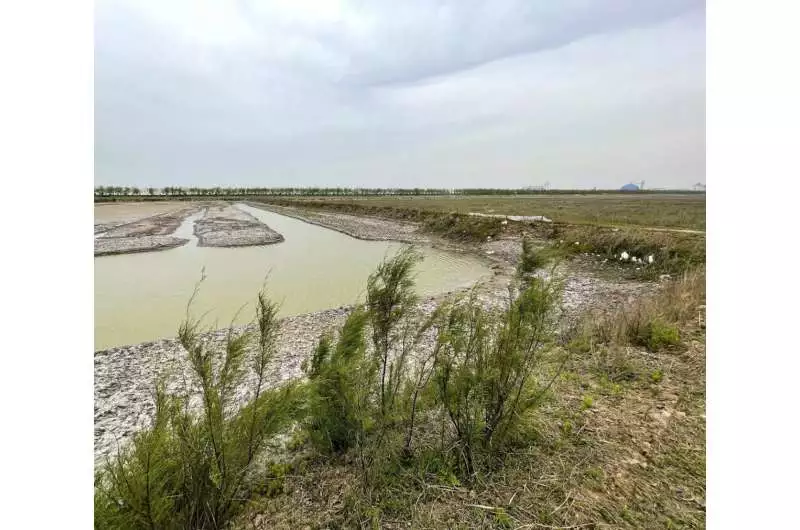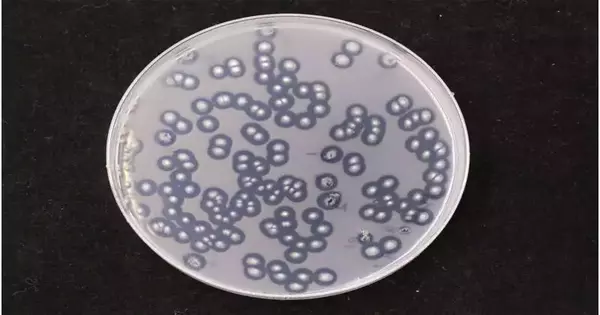A diverse microbiome of plastic-degrading fungi and bacteria in the coastal salt marshes of Jiangsu, China, has been discovered in a new study that was published in the Journal of Hazardous Materials by researchers at the Royal Botanic Gardens, Kew, and partners.
Polycaprolactone (PCL), a biodegradable polyester commonly used in the production of various polyurethanes, was broken down by 184 fungal and 55 bacterial strains, according to the international research team. Other petroleum-based polymers—natural or synthetic chains of molecules bound together—can be further degraded by bacterial strains belonging to the genera Jonesia and Streptomyces.
In May 2021, the plastic-degrading microorganisms were taken from Dafeng, an area of eastern China that is protected by UNESCO and is close to the Yellow Sea Coast. The sampling confirmed the existence of a terrestrial plastisphere, a term relatively new to terrestrial ecology because previous research has primarily focused on marine settings. In addition, it was discovered that the soil surrounding this “man-made ecological niche” of coastal plastic debris had a distinct microbiome.
“We chose to investigate the microbial communities present in the plastic waste present in the Dafeng salt marshes precisely because of the ecological niche, and so far our findings have proven to be both exciting and promising.”
Dr. Irina Druzhinina, Senior Research Leader in Fungal Diversity and Systematics at RBG Kew,
Microorganisms like fungi and bacteria are being studied more and more by scientists to address some of today’s most pressing issues, like the rising tide of plastic pollution. The United Nations Environment Program (UNEP) says that 400 million tons of plastic waste are made every year, and the amount of plastic pollution has gone up a lot since the 1970s. However, researchers are hopeful that the plastisphere may hold the solution to this issue.
Past examination has previously perceived the capability of microorganisms to handle plastic waste. A strain of the fungus Aspergillus tubingensis that was breaking down plastic at a landfill in Islamabad, Pakistan, was discovered in a 2017 study led by researchers from China and Pakistan. 436 different fungi and bacteria have been found to break down plastic, and Kew scientists and their collaborators believe that their most recent findings could lead to the creation of effective enzymes that can biologically break down plastic waste.
The research comes before World Environment Day 2023, which is on June 5, and is about finding solutions to the problem of plastic waste through the campaign #BeatPlasticPollution.
“Microbiologists across the board feel responsible for finding solutions to the ecologically friendly treatment of plastic waste because bacteria and fungi will be the first organisms to learn how to deal with this new material,” says Dr. Irina Druzhinina, Senior Research Leader in Fungal Diversity and Systematics at RBG Kew. We have presumably assumed that organisms will sort out approaches to actually degrade plastic; however, this might require millennia assuming we pass on nature to run its course. Because of this, our duty is to make use of the knowledge we already have about microbial biology to accelerate and direct the evolution of microbes and their individual genes so that they can perform their current function.”
In view of their life span and hydrophobic surface, plastics in sea-going environments have made a ‘microbial reef’ of sorts for growths and microorganisms to connect to. Additionally, some biodegradable plastics have the potential to provide microbes with a food source and a source of carbon for them to metabolize. The researchers gathered fifty samples of plastic waste from seven distinct petroleum-based polymers at Dafeng: expanded polystyrene (EPS), polyethylene (PE), polyurethane (PU), polyamide (PA), polypropylene (PP), and polyvinyl chloride (PVC), all examples of polyethylene terephthalate (PET).
The researchers found 14 different genera of fungi in the samples, including the plant pathogens Fusarium and Neocosmospora. Fungi that are pathogenic for plants obtain their nutrients from plants in a manner that is harmful to their host. These fungi may be better at breaking down PCL plastics and other synthetic polymers than saprotrophic fungi, which feed on the remains of dead animals and plants.
“The ecological niche of the Dafeng salt marshes is exactly why we chose to investigate the microbial communities present in the plastic waste there, and so far our findings have proven to be both exciting and promising,” Dr. Druzhinina continues.

The review has affirmed the presence of an ‘earthbound plastisphere’ environment. The microbiome of this plastisphere was viewed as unmistakable from the encompassing soil. Credit: Feng Cai and Irina Druzhinina
In the wild, parasites play a critical role in breaking down natural matter and moving it through the carbon cycle. The capacity to break down numerous complex and naturally occurring polymers, like cellulose, has developed over millions of years. As a matter of fact, the catalysts emitted by growths are very effective at separating complex natural mixtures, including sugars and proteins.
The research team identified Streptomyces and the newly discovered genus Jonesia as promising candidates for plastic degradation alongside the fungi at Dafeng. Particularly in the genus Jonesia, see The 55 bacterial strains that were sampled all belonged to Quinghaiensis.
“The opportunity to work on a project with potentially impactful solutions to tackling rising levels of plastic pollution across the globe was an immediate draw, particularly as this was my first research project,” says Xuesong Li, a master’s student at Nanjing Agricultural University in China. There was some underlying concern that we probably wouldn’t accumulate an adequate amount of information from a solitary examination; however, the outcomes so far have been overpowering, and we have needed to control ourselves from separating an ever-increasing number of societies to concentrate on their qualities. What’s more, however microbes demonstrated exceptionally dynamic in such a manner, I for one preferred working with growths, as these organic entities have huge potential for applications a long way past the corruption of plastic.”
The authors of the study caution that, despite numerous exciting advancements in the field, our comprehension of microorganisms associated with plastic is still in its infancy. There are still a lot of unanswered questions about these ecological niches, and the authors of the study faced some difficulties in precisely identifying the analyzed strains down to the species level.
“What strikes me the most is the sheer power of microbial diversity, especially when you consider how difficult it is to detect them,” says Dr. Feng Cai of Sun Yat-sen University in Shenzhen, China. Their size is microscopic, their nature is secretive, and their appearance is straightforward. However, if we shift our perspective and look at them through the lens of biochemistry, we discover a wealth of complexity that begs to be explored. It is genuinely invigorating to acknowledge that we have scarcely started to expose what’s underneath and have proactively found an abundance of potentially encouraging assets for future innovations. Knowing that there are still numerous discoveries to be made and that our work has the potential to lead to significant advancements in the field, this realization gives me a tremendous sense of fulfillment.
RBG Kew is home to one of the most established and greatest fungaria on the planet, with more than 1.25 million examples; however, the realm of growths remains one of the most extraordinary and enormous secrets of the normal world. In addition to the more than 144,000 species that have been described thus far, estimates vary, but scientists are confident that among them are new sources of food, medicine, and other beneficial compounds.
More information: Guan Pang et al, The distinct plastisphere microbiome in the terrestrial-marine ecotone is a reservoir for putative degraders of petroleum-based polymers, Journal of Hazardous Materials (2023). DOI: 10.1016/j.jhazmat.2023.131399





